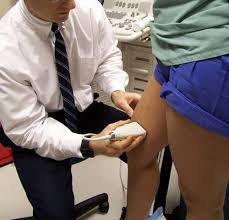Restless Leg Syndrome and Leg Vein Disease RLS
What is restless leg syndrome (RLS)?
Restless leg syndrome, also known as RLS, is a poorly understood disorder that affects the nervous system. RLS is characterized by unpleasant sensations in the legs. Symptoms include an often overwhelming sensations in the legs that can include the sensation of your “skin crawling,” throbbing, itching, and / or “pins and needles sensation” in the legs. The symptoms tend to be much worse at rest, especially when lying down or sitting. There is typically an irresistible urge to move the legs in order the relieve these underlying symptoms, as the leg symptoms can often be temporarily relieved by movement of the legs.
The severity of RLS symptoms tends to vary widely from patient to patient. Some patients have very frequent and daily symptoms, whereas in others the symptoms are intermittent and come and go. For some people the symptoms occur most severely at night and cause severe impairment in their sleep patterns, markedly affecting their quality of life. The condition is often misdiagnosed or unrecognized. RLS can be treated effectively.

What Individuals Are Prone to RLS?
RLS is a very common condition, with roughly 10% of the population in the United States having restless leg syndrome. Although it does affect women more commonly, it is frequently seen in men as well. It can affect individuals of all ages, even children. The most severe cases seem to involve middle aged individuals or the elderly.
Causes of Restless Leg Disease
1) Vein Insufficiency of the Legs, also known as Venous Reflux Disease
2) Varicose Veins
3) Peripheral Neuropathy
4) Iron Deficiency
5) Electrolyte or Mineral Disturbances
6) Diabetes
7) Kidney Disease
8) Parkinsons Disease
9) Neurological Disorders or Nerve Diseases
10) Nerve or Brain Injury
11) Medications, including certain antipsychotic drugs, antidepressants, and anti-nausea drugs
12) Alcohol or illicit drugs
13) Pregnancy
14) Peripheral Vascular Disease
Treatments for Restless Leg Syndrome
There are multiple treatments available for treating the conditions of RLS. But the most important thing to consider prior to starting any treatment for restless leg syndrome is “What is the underlying reasons that I am developing RLS symptoms?” Like any medical condition, the optimal therapy is to determine the underlying cause and then fix the underlying cause so that the condition is cured and the symptoms resolve. Unfortunately, all too often the SYMPTOMS of RLS are treated with medications rather than the underlying condition being determined and fixed. Examples of commonly used drugs to treat RLS symptoms are Ropinirol, Requip, and Gabapentin. It is also advised to decrease the intake of caffeine, alcohol, and tobacco. Exercise, massage, and good sleep patterns can also help diminish symptoms.
But does it not make more sense to do testing for the underlying cause and then fix any underlying condition that is leading to the RLS symptoms? The answer is yes. Since vein disease and vascular disease is a very common cause of RLS symptoms, it is advised that all patients with symptoms of restless leg symptoms undergo vascular testing to rule out underlying venous insufficiency in their legs. This is done through a simple ultrasound test in the doctors office.
There has been much research on RLS that concludes that venous disease is a leading cause of restless leg syndrome and that treatment of this venous disease often leads to resolution of the symptoms. This research has lead to numerous advisory articles being released by the National Institute of Health (NIH) advising physicians and other health care providers to refer patients for vein testing prior to check for possible venous insufficiency prior to prescribing drug therapy for the symptoms of RLS. Two of the NIH articles, which can be accessed online through PubMed, are below:
ARTICLE 1 on Restless Leg Syndrome
ARTICLE 2 on Restless Leg Syndrome
How do I Get Tested for Possible Vein Insufficiency as the Cause of My RLS?
Contact our vein center to schedule a special type of leg ultrasound study called a Venous Reflux Ultrasound. The study only involves the use of an ultrasound machine and can be performed in about 15 minutes on each leg. There is no x-rays or irrradtion administered, as it solely utilizes sound waves. No IV is required . . . just ultrasound gel on the legs. The study is quick and painless and can conclusively determine if vein disease is causing your Restless Leg Syndrome. This ultrasound study is typically covered by all major insurance plans and Medicare. If your ultrasound study confirms the presence of vein disease, then our board-certified Vein Specialist will meet with you to discuss your treatment options.

Are Vein Treatments to Cure Vein Disease Covered by Health Insurance?
Depending on the severity of your symptoms and the ultrasound findings, treatment of vein disease is usually a covered benefit under most major insurance plans. Our office staff will discuss this with you and will work with your insurance company to try to get the treatments covered for by your health insurance. We offer a no-obligation consultation to discuss your options if you are diagnosed with vein disease.
Please call our Vein Center at (512) 220-5401 to arrange an ultrasound or Physician Consultation to discuss your RLS symptoms.


